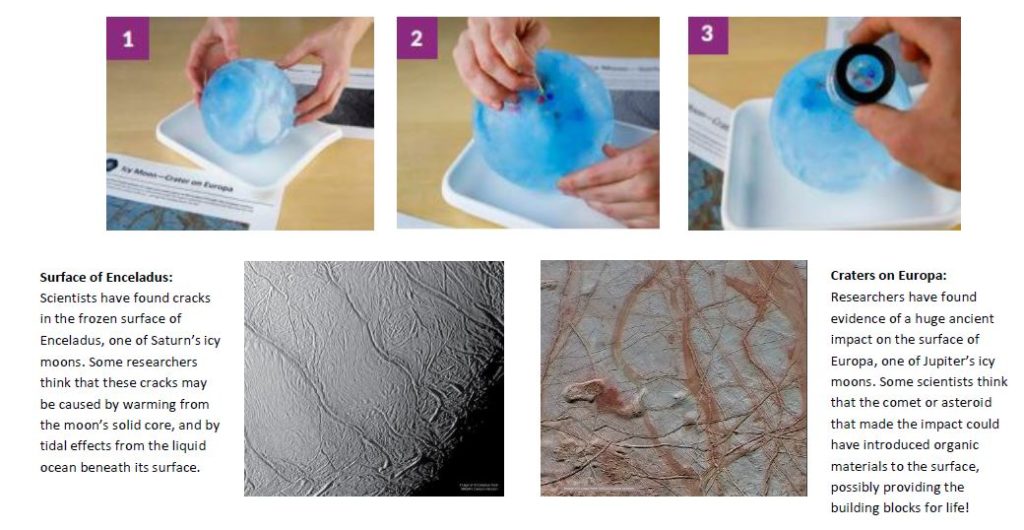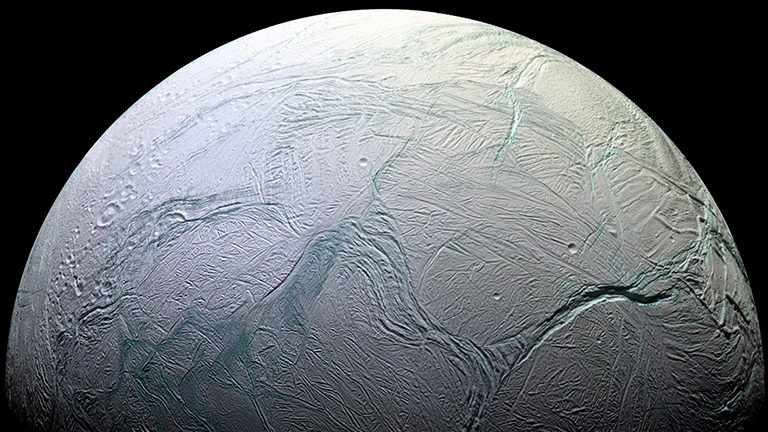Post written by Angela Kettle, School Programs Coordinator. Adapted from the National Informal STEM Educator’s Network (NISE Net) under a Creative Commons Attribution Non- Commercial Share Alike 3.0 United States (CC BY-NC-SA 3.0 US).
Daily Discovery: Looking for Life – Ice Orbs
Ocean worlds may be the most likely places to discover life beyond Earth. To study distant ocean worlds, scientists make observations using a variety of tools and then compare the data to geological processes on Earth. Sometimes scientists can use telescopes based on Earth to observe these far-off places, and sometimes they gather data using spacecraft with special instruments. Explore your own ice orb using tools in the activity below!
Supplies:
To make ice orbs (see Preparation instructions below):
- 1 party balloon
- Small funnel
- Very small items like confetti, chia seeds, crushed cereal, etc. (use what you have!)
- Liquid watercolor or food coloring (optional)
To complete activity:
- Ice orbs (prepared in advance—see instructions below)
- Tray, plate, or other surface
- Towel
- Magnifying lens (optional)
- Flashlight (optional)
- Toothpicks (optional)
- Paper clips (optional)
Ice Orb Preparation:
Note: This activity is most fun when you have one person prepare the orb, and another person explore it! All steps listed below can be adjusted based on the materials you have at home. The important thing is that you place small items in the orb, fill it with the appropriate amount of water, and leave it to freeze.
- Add 2 to 4 drops of liquid watercolor or food coloring to the inside of each balloon.
- Use the small funnel to add a tiny pinch (about ¼ teaspoon) of chia seeds, crushed cereal, confetti, and other very small items you’ve collected. Less is more! Do not add too much.
- Place the neck of the balloon over a faucet and hold it tightly. Slowly turn on the tap and fill the balloon with water, until it is about 6 to 8 inches in diameter. Be sure you add enough water to get a round shape rather than an elongated (egg) shape. Pinch the neck of the balloon closed and carefully remove it from the faucet.
- Release any remaining air from the neck of your balloon or the confetti won’t be encased in ice. Tie off the balloon.
- Place the balloon in a freezer, leaving them for two days or until frozen. Tip: You can rest the filled balloon in a small round-bottomed bowl to help them hold a more spherical shape while it freezes. To get the roundest shape, freeze the balloons knot-side down.
- Just before you start the activity, cut the neck of the balloons and peel the balloons off the ice orbs.
Instructions:
- Look closely at the ball of ice. What do you see on the outside and the inside? Compare what you see to the images of icy moons (Europa and Enceladus) below.
- Choose an object hidden under the surface of the ice below. What do you observe? Try using tools like your flashlight, magnifying glass, and toothpicks to get more information!
- Can you tell what the hidden object is made of? Is it alive? How could you learn more about the object or the ice?
- Explore other ocean worlds here.

Ocean Worlds Beneath
Scientists think that ocean worlds have icy, frozen exteriors and warmer, liquid interiors. Examples of ocean worlds in our solar system include Jupiter’s moons Europa, Ganymede, and Callisto, and Saturn’s moons Enceladus and Titan. The ice orbs you investigated in this activity are different from these ocean worlds, because they’re frozen all the way through.
Astrobiologists are searching ocean worlds for evidence of life. Because water is essential to life on Earth, some scientists think that ocean worlds are the most likely places to find living things in other parts of the universe. NASA missions such as Juno and Cassini are contributing data to astrobiology research. In the future, NASA researchers hope to send scientific missions to these cold and alien worlds to gather more data. Future missions might take better images, analyze the chemical and mineral compositions of the oceans, and probe the surfaces and interiors of these planetary bodies.
Questions to Ponder:
- On the recent Juno mission to Jupiter, scientists made the decision to deorbit—or crash—the spacecraft into Jupiter to avoid contaminating Jupiter’s moons with microbes from Earth. Was this the right thing to do?
- What tools should we use to study life on other worlds if we find it? Should we bring samples back to Earth and risk endangering species native to our own planet?
Credits:
Funding: This material is based upon work supported by NASA under cooperative agreement award number NNX16AC67A. Any opinions, findings, and conclusions or recommendations expressed in this material are those of the author(s) and do not necessarily reflect the view of the National Aeronautics and Space
Administration (NASA).
Owning institution: The Science Museum of Minnesota
Permissions: Creative Commons Attribution Non-Commercial Share Alike 3.0 United States (CC BY-NC-SA 3.0 US).
Image credit: NASA
Want to download these directions? Click here for a handy PDF!
Follow along with our Daily Discovery! Click here for all activities that you can do at home.

